Dogs and puppies hold a special place in the hearts of many. Their boundless energy, unconditional love, and joyful companionship are what make these furry friends not just pets, but cherished members of the family. Whether it’s the tiny paws of puppies or the loyal gaze of adult dogs, each canine brings a unique presence into a home. Across the vast array of dog breeds, from the tiny Chihuahua to the majestic Great Dane, there’s a perfect companion for every lifestyle and personality. Finding the right match is a journey of joy and discovery.

Adoption from shelters and rescues is a beautiful way to bring a dog into your life while making a profound difference. Animal shelters and rescue groups are brimming with dogs and puppies of all breeds and ages, each awaiting a loving home. By adopting, potential pet owners not only provide a home but also open up valuable space for these organizations to help even more animals in need. Prospective adopters become part of a compassionate community that values the wellness and proper care of these affectionate companions.
When one chooses to adopt a dog, they are not just selecting a pet; they are welcoming a new member into their family and embarking on a rewarding relationship. Caring for a dog involves more than providing food and shelter; it’s about ensuring their overall well-being, from regular veterinary check-ups to daily affection and exercise. The process of adopting pets from animal shelters or rescue groups can be both an act of kindness and a source of joy, as each dog adopted paves the way for others to find their forever homes.
The First Meeting
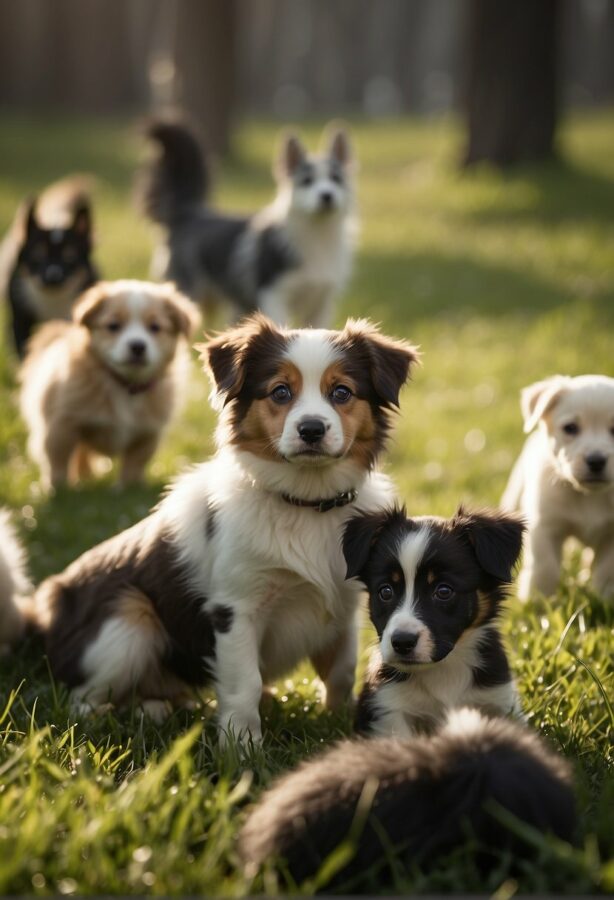
When adopting pets, especially puppies, from animal shelters, the first introduction can set the tone for their new life at home. They say first impressions last, and this is no less true for the first encounter between a new owner and their furry friend.
Before the Meeting
- Plan for calm: Ensure the meeting area is serene.
- Permission is key: Always ask the current caretaker if it’s alright to interact.
During the Introduction
- Allow the dog to come to you.
- Offer a non-threatening posture by turning slightly to the side.
- Extend a hand, fingers down, for a gentle sniff—the dog’s ‘handshake.’
- Speak softly to create a comforting atmosphere.
For the Canine Resident
- If a dog already calls your house ‘home,’ introduce the new pet on neutral ground.
- Keep both on leashes for control.
- Observe their body language closely for signs of stress or tension.
For Puppies
- Support their explorative nature but keep meetings short to not overwhelm them.
- Presenting toys can ease anxiety and offer an immediate shared activity.
The Home Environment
- For puppies entering a home, introduce them to their new environment one room at a time.
- Equip the space with comforting items like a bed and toys.
Remember, slow and steady ensures that dogs and puppies alike become comfortable and find their place within their new family and environment gently and lovingly.
Playtime Antics
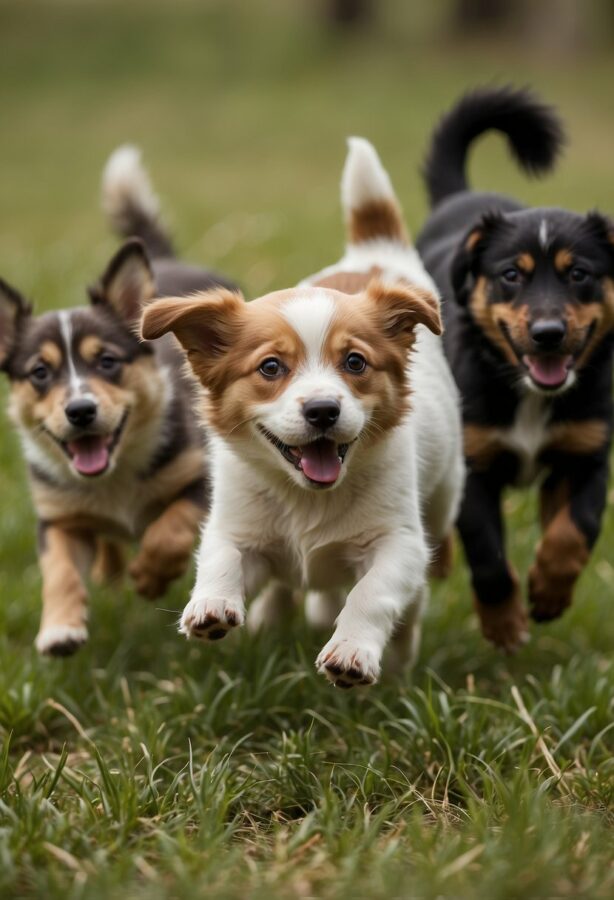
Playtime is an essential aspect of a puppy’s life, offering opportunities for exercise, socialization, and learning good manners. During these joyful occasions, puppies exhibit a range of adorable behaviors as they interact with their environment and companions.
Engagement with Toys: Puppies express their curiosity through play by investigating various dog toys. A game as simple as fetch can captivate a puppy’s attention, as they eagerly chase and retrieve the toy, wagging their tails in excitement. Owners should ensure toys are safe and size-appropriate for their puppies to prevent any risks during playtime.
Learning Through Play:
- Puppies learn bite inhibition as they play with their peers.
- A yelp from a playmate teaches them the boundaries of acceptable play.
- Through these interactions, they develop good playtime manners.
Activities for Bonding: Owners can strengthen their bond with their puppies through play. Engaging in tug-of-war or hide-and-seek provides mental stimulation and helps puppies burn off energy. It’s crucial to incorporate positive reinforcement during play, rewarding puppies with treats or affection to encourage good behavior.
Feeding as Part of Routine: Integrating feeding time with play can teach puppies patience and discipline. For example, using feeding puzzles during playtime challenges them mentally, turning mealtime into an entertaining and enriching experience.
Remember, each puppy has a unique personality, and their playtime preferences can vary. Observing a puppy’s behavior during these playful antics can provide insights into their character and help guide their training and development. With patience and understanding, owners can ensure that playtime is both fun and educational for their beloved puppies.
See Related: The Purr-fect Pair: Celebrating Cats and Dogs Together
Naptime Buddies
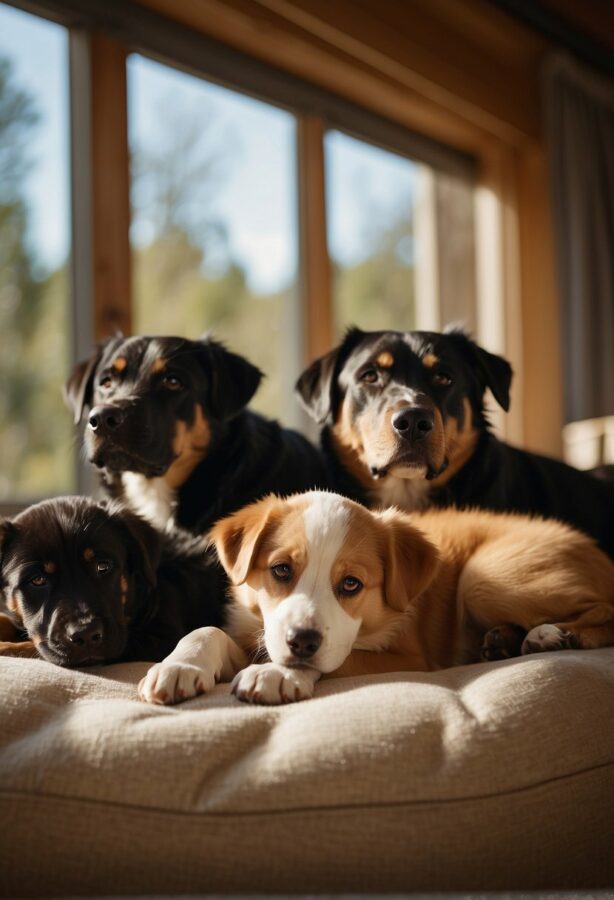
In the lives of dogs and puppies, naptime is a cherished ritual vital for their wellness and health. While an adult dog may spend an average of 12 to 14 hours sleeping each day, puppies, enveloped in growth and development, require even more rest—sometimes up to 20 hours.
A heartwarming scene unfolds as dogs and puppies find comfort and security in each other’s company during these restful periods. A puppy, nestled against the warm, reassuring side of an older dog, instills a sense of adoration. These moments are more than mere naps; they’re times of bonding and learning, as pups gain a sense of safety and pack mentality from their sleeping companions.
The concept of “Naptime Buddies” reflects not just a practical routine, but a spectrum of dog health benefits:
- Stress Reduction: Closeness during naps lowers stress and promotes relaxation.
- Temperature Regulation: Puppies snuggle with their elders to maintain body warmth.
- Comfort: A rhythmic heartbeat and gentle breathing provide a sensory environment that encourages deep sleep.
Benefits of Naptime Buddies | Description |
|---|---|
Emotional Security | Puppies feel protected, enhancing their confidence. |
Health and Growth | Consistent sleep supports healthy growth. |
Social Skills | They learn appropriate behaviors from older dogs. |
Their naptime configurations can be as simple as a tangled heap or as adorable as a perfectly synchronized side-by-side repose. Each slumber is like an unspoken pact of trust and fellowship in the dog world, with every puppy’s twitch and sigh adding a layer to their ever-evolving relationship. Therein lies the true essence of “Naptime Buddies”—an idyllic and essential feature in the life of every furry companion.
See Related: What is Kirkland Dog Food Comparable to? Find out the Top Alternatives
Learning to Walk
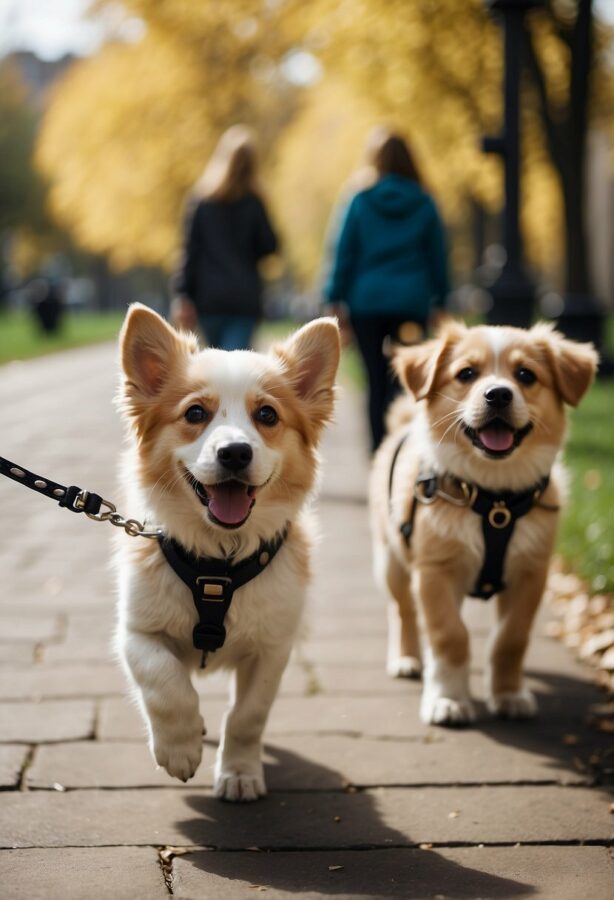
Training a puppy to walk on a leash is a crucial step in their development, fostering both obedience and exploration. A puppy typically starts walking between 4 to 8 weeks of age, but leash training may begin only when they’re comfortable with a collar or harness.
Introducing the Leash
- Familiarization: Allow the puppy to feel the texture of the leash by laying it near them during play.
- Wearing the Gear: Gradually introduce the collar or harness, letting the puppy wear it for short periods.
Initial Steps Inside
- Start by guiding the puppy around the house.
- Keep sessions short, upbeat, and punctuated with play to associate the leash with fun.
Timing of Walks
- Morning walks are often ideal, as they help with house training and set a positive tone for the day.
- Avoid the hottest parts of the day to protect their sensitive paws and prevent overheating.
Outdoor Adventures
- Short sessions in a safe, enclosed outdoor space can begin once the puppy shows confidence indoors.
Positive Reinforcement
- Always use treats, praise, and petting to encourage and reward desired behavior.
By breaking down the training process into manageable steps and maintaining a gentle, rewarding approach, owners guide their companion through a fundamental aspect of dog behavior. They are not just teaching a skill—they are growing a bond with their adorable pup, who’s eager to explore the world at their side.
The First Bark

Newborn puppies enter the world with limited senses, primarily communicating through soft whimpers and coos to signal their needs. While breeds vary, most puppies typically begin to bark around 7 to 8 weeks of age. This initial form of vocalization is often an adorably timid yip that grows more confident as the puppy matures.
A puppy’s first bark is a significant milestone in their development, reflecting both their growing sensory and communication abilities. In dog behavior, barking can convey different messages, from excitement and playfulness to anxiety or a defensive alert.
Here’s a brief look at what to expect:
- 3-4 weeks: Puppies may grunt or whine.
- 7-8 weeks: Tentative barks may emerge.
- 16 weeks and up: Barking becomes more pronounced and mirrors adult dog patterns.
Specific dog breeds may exhibit variations in how soon and how frequently they bark. Hound breeds, known for their characteristic howls and barks, may start vocalizing sooner and more robustly. Conversely, some toy breeds or naturally quieter breeds might bark less, even as they grow older.
Puppy owners often recall the first time they hear their furry friend’s initial attempts at barking with a sense of endearment. Witnessing their little one’s bark evolve from a quaint peep to a full-fledged woof is both heartwarming and a herald of the dog they will become. Whether a protective German Shepherd or an enthusiastic Beagle, every puppy finds its voice in its unique way, marking the beginning of their journey in expressing themselves.
Mealtime Mayhem
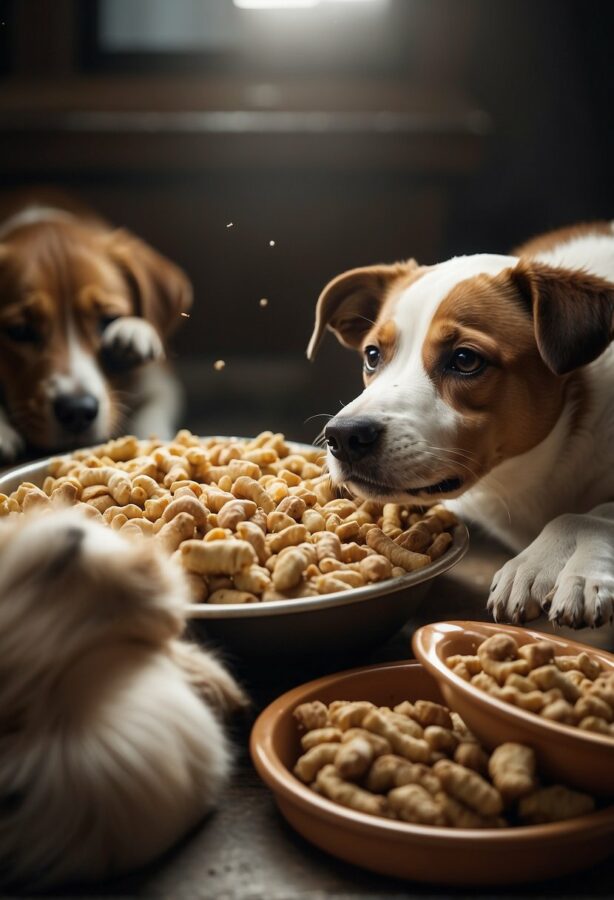
When it comes to feeding one’s furry companions, mealtime should be a moment of nourishment and peace. Yet, for those with multiple pets, especially dogs, it can escalate into a display of food guarding and competition. Maintaining control is key to preventing these canine conflicts and creating a harmonious environment for all members of the pack.
Mealtime Strategies for Multi-Dog Households:
Individual Feeding Areas: To maintain order, it’s essential to assign each dog its own feeding space. This helps in reducing confrontations over food.
Consistent Schedule: Puppies and adult dogs alike benefit from a predictable feeding routine. This predictability helps reduce anxiety and competition because they learn when to expect their meals.
Training for Calm Behavior: Encouraging dogs to sit and wait patiently before meals can instill discipline and control during feeding times.
Health Considerations:
Supervision is Vital: Close monitoring during mealtime ensures that each dog gets the right amount of food, which is crucial for their health and well-being. Overfeeding can lead to obesity, while underfeeding can cause nutritional deficiencies.
Adaptable to Age: Puppies may require more frequent feeding intervals with food that caters to their developmental needs, unlike adult dogs who generally need just two meals a day.
Incorporating these strategies leads to a smoother mealtime, where each dog and puppy knows their place, understanding the wait for their own bowl is short. This routine not only promotes better behavior but also better health for each tail-wagging member of the family.
Puppy Piles

When one imagines a bundle of joy, the sight of puppy piles often comes to mind. These adorable mounds of fur are more than just a darling spectacle; they serve important functions in puppy development and wellness.
Dog Behavior:
Puppies instinctively huddle together into cozy clusters, a behavior stemming from the need for warmth and the comfort of their littermates’ heartbeat and presence. These puppy piles not only provide warmth but also build a foundation for future social behaviors.
- Comfort: Puppy piles emulate the warmth and security felt with their mother.
- Sleep: Huddling together helps puppies feel secure, promoting deeper sleep.
- Play: As they grow, piles become the epicenter of play, teaching boundaries.
Wellness:
The health benefits of such closeness cannot be overstated. These interactions help puppies regulate body temperature and build strong immune systems by sharing benign bacteria.
Factor | Benefit |
|---|---|
Temperature | Maintains body heat in early life |
Immunity | Exchanges microbes, builds immunity |
Puppy piles also represent the beginning of their journey into doghood, learning to interpret and communicate through a delicate dance of yips, yawns, and tiny tail wags. As they cuddle up, each puppy contributes to the tale of their emerging personalities and the bonds they share with their future human companions.
First Bath

When a new puppy arrives in one’s home, the first bath is a milestone in their health and wellness journey. Puppies should ideally have their first bath around eight weeks of age, as they are generally old enough to regulate their body temperature and can handle getting wet.
Before Bathing
- Determine the puppy’s coat type to choose the right shampoo and conditioner.
- Use lukewarm water and make sure the bathing area is secure and slip-free.
- Gather supplies such as towels, a gentle dog-specific shampoo, and treats for positive reinforcement.
During the Bath
- Slowly introduce the puppy to the water, being careful to avoid their eyes and ears.
- Gently massage the shampoo into their coat, creating a pleasant experience for them.
- Rinse thoroughly to prevent any soap residue, which could cause irritation.
Post Bath
- Wrap the puppy in a warm towel to dry off.
- Give plenty of praise and some treats – turning the experience into a positive one.
- Ensure they’re completely dry and avoid drafts or chilly environments post-bath.
Bathing not only keeps puppies clean, but it also serves as an excellent opportunity to check for any skin issues or external parasites that might affect their wellbeing. It’s a chance to strengthen the bond between the owner and their new furry family member while taking an active step in maintaining the puppy’s health. It’s essential, however, not to bathe puppies too frequently, as their skin needs the natural oils for protection. When necessary, a loving bath every three months could suffice, unless they become particularly dirty.
Meeting the Family
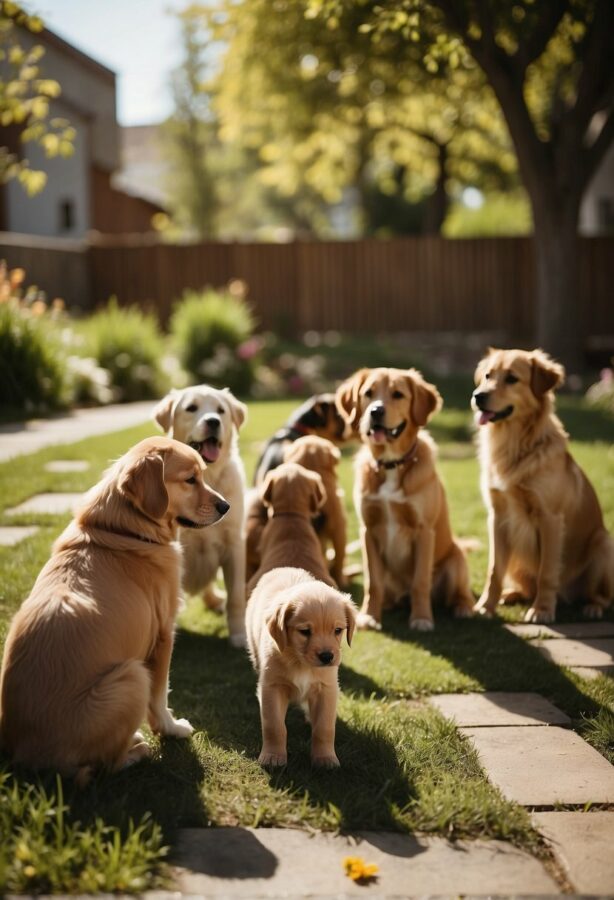
When a new puppy or dog enters their forever home, it’s an adorable time for both the pet and human family members. The introduction should be approached with tenderness and patience to ensure everyone, including existing pets like cats or kittens, feels comfortable.
For Human Family Members:
- Start with one person at a time to prevent overwhelming the new canine.
- Encourage calm interactions, allowing the dog to approach.
- Use treats to associate family members with positive experiences.
Introducing Feline Siblings:
- Keep dogs on a leash to manage their behavior.
- Allow cats or kittens to observe the new dog from a safe distance.
- Provide cats with an escape route or high places to retreat if needed.
Existing Dogs in the Home:
- Introduce dogs in a neutral area.
- Observe body language for signs of friendliness or tension.
- Consider parallel walks to foster side-by-side bonding.
Other Types of Pets:
- For small furry or feathered pets, introductions might best be avoided to prevent predatory behavior.
- Always supervise interactions between the new dog and other pets.
When adopting a new friend into a household, it’s key to respect the pet’s pace and comfort levels. Early positive experiences help engrain the feeling of safety and acceptance in their new abode.
Outdoor Adventures
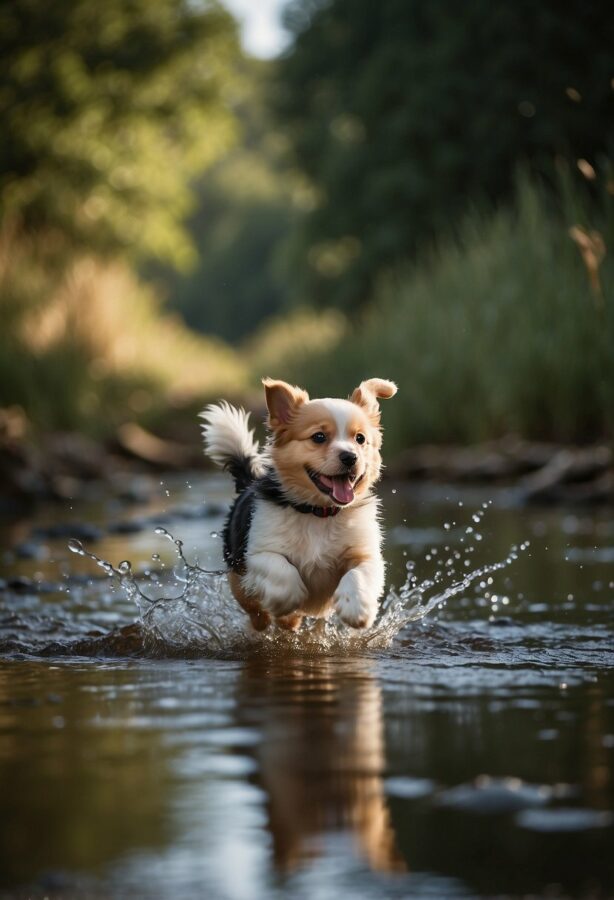
Taking your furry companion on outdoor adventures offers an excellent opportunity for them to engage in physical exercise and mental stimulation. Not only do such activities foster a strong bond between pet and owner, but they also contribute positively to a dog’s health and behavior.
Most breeds thrive when given the chance to explore and play outdoors, but some are particularly well-suited for such experiences:
- German Shepherds are known for their intelligence and versatility, excellent for a wide range of outdoor activities.
- Huskies possess a remarkable endurance and love for the cold, making them perfect for snowy treks.
- Australian Cattle Dogs and Border Collies exhibit high energy and agility, ideal for hiking and playing fetch.
- Dalmatians are known for their stamina, embracing long walks with enthusiasm.
When preparing puppies for outdoor adventures, training and socialization are vital. They should learn to respond to commands to ensure they remain safe and under control.
Consideration | Description |
|---|---|
Training | Basic commands like stay, come, and heel are essential. |
Health | Ensure they are up to date with vaccinations and check-ups. |
Behavior | Teach them to interact with other dogs and humans appropriately. |
Dog Gear | A proper leash, collar, and identification tags are necessary. |
For those considering adopting pets, choosing a breed that aligns with your lifestyle is crucial, especially if you prefer an active life outdoors. Puppies and dogs from shelters can also make incredible outdoor companions with the right training and care. Such shared experiences can lead to a healthier, happier life for both the pet and the owner.
Training Triumphs
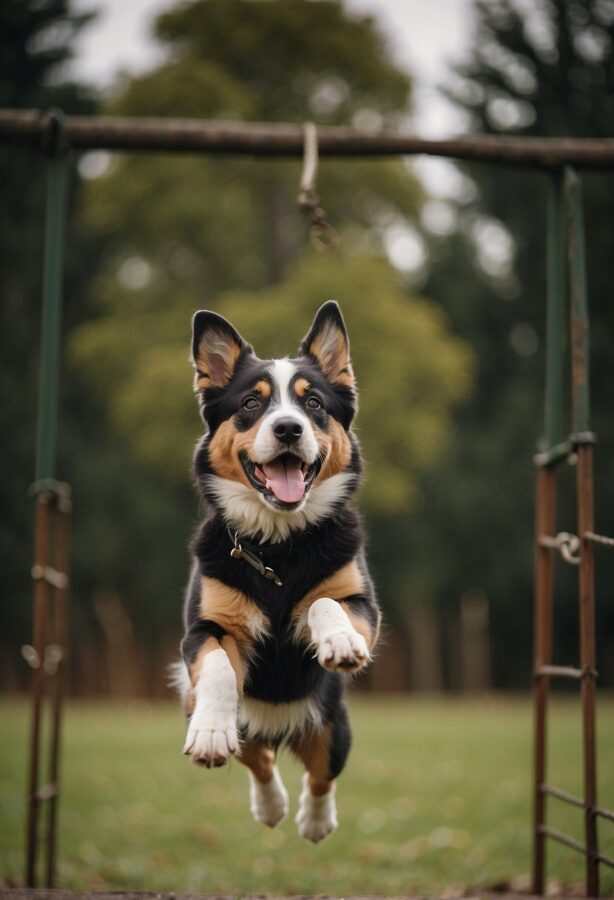
In the journey of raising puppies and guiding dogs, training triumphs are milestones that mark the progression of furry companions into well-mannered members of the family. Training is crucial—it fosters a mutual understanding and builds a language of respect and trust between pets and their owners.
Puppies often begin their training with basic commands like sit, stay, and come. Encouragement and consistency are key; a puppy who learns to associate positive behavior with rewards will eagerly repeat the action. It’s a dance of cause and effect, where the treat acts as a joyful punctuation.
Age | Training Goals | Rewards |
|---|---|---|
2-4 months | House training, Name recognition | Praise, treats |
4-6 months | Basic commands (sit, stay), Leash training | Toys, longer play sessions |
6+ months | Advanced commands, Behavioral refinement | Socialization opportunities |
Dog training often involves a shift from simple commands to complex behaviors. Through reinforcement and positive methods, dogs of all ages and breeds can learn the art of patience and the grace of obedience. Training should not be seen as a rigorous chore but as an enjoyable bonding experience that both the dog and owner look forward to each day.
When it comes to adopting pets, understanding an animal’s background can be vital. A rescue dog may have different behavioral needs than a puppy. Tailoring the approach to their past experiences ensures that each dog receives the nurturing they need to thrive. With patience and specialized training, adopted dogs often overcome their past to find confidence and happiness in their new homes.
As each training session unfolds, it’s not just about the commands—it’s about the silent language of love and the joyous leaps of a puppy mastering a new task. The true triumph is seen in the wagging tails and bright, eager eyes ready to learn and please.